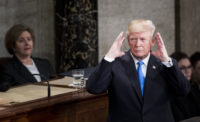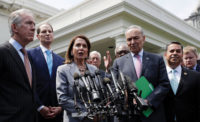Construction industry officials are trying to assess the impact of President Trump’s recently reported comments that seemed to indicate he is moving away from drawing on public-private partnerships (P3s) in his long-promised, still unreleased infrastructure proposal. But if one result is a larger amount of direct government funding in the plan, that's something industry officials would welcome.
Published reports say that at a Sept. 26 White House meeting with House Ways and Means Committee members, Trump appeared to reject a major role for private financing in what he has repeatedly said will be a $1-trillion, 10-year infrastructure initiative.
Administration officials, such as Office of Management and Budget Director Mick Mulvaney, have said the plan would include $200 billion in federal funding, leveraging an additional $800 billion in nonfederal investment.
The Washington Post quoted one attendee at the White House meeting, Rep. Brian Higgins (D-N.Y.), as saying that Trump “emphatically rejected what everybody assumed was his position relative to financing infrastructure….He dismissed [private financing] categorically and said it doesn’t work.” A Higgins aide didn’t respond to ENR requests for comment and confirmation about the meeting.
Steve Hall, American Council of Engineering Companies vice president for government affairs, says that if the P3 comments are true, they indicate a significant shift on Trump’s part. But Hall adds, “What remains to be seen, is this just one of those unscripted moments or does it truly represent a major change in direction.”
At ACEC, he says, “We certainly think an infrastructure package that has P3 components to it is worthwhile. But the fact that the president made comments suggesting that he wants to put more emphasis in direct spending is something we very strongly support.”
Other industry officials and some in Congress, also have been advocating that direct spending should be a major part of a new infrastructure funding proposal.
Brian Turmail, an Associated General Contractors of America spokesman, says, “We’ve long argued that these early reports that the administration was apparently thinking of a ratio of 20% funding from the public sector to 80% financing from the private sector…was way off.”
Turmail adds, “There’s clearly a role for the private sector to play, but we think that the main responsibility ought to come through public-sector funding.”
Bud Wright, American Association of State Highway and Transportation Officials executive director, declined to comment about Trump’s reported remarks. Wright added, via email, that “it has been AASHTO’s long-standing position that any viable Federal transportation investment package must include a combination of funding and financing options, of which…P3s will play a role.”
Wright said, “P3’s by their very nature cannot work everywhere. Old fashioned direct federal funding will be needed to ensure that America’s vital transportation systems can meet the needs of our growing population for years to come.”
Senate Environment and Public Works Committee Chairman John Barrasso (R-Wyo.) “has said that [P3s] may work for larger urban areas but that they typically aren’t as successful in rural communities,” a spokesman says.
The aide adds that Barrasso, whose panel has jurisdiction over federal highway and water infrastructure policy, “plans to work with the administration and the committee to move an infrastructure bill that addresses the needs of all of America.”
The Senate committee’s top Democrat, Tom Carper (Del.), along with the other Democrats on the panel, wrote to DOT Secretary Elaine Chao on Sept. 27, seeking a meeting with her or other officials “to share the administration’s long-awaited infrastructure plan.”
Carper noted that Democrats in January had proposed their own $1-trillion, 10-year infrastructure proposal, all of which would be direct federal spending, and “stand ready to work with our Republican colleagues on a significant infrastructure effort such as the one we have proposed.”
In past months, administration officials had been talking up private infrastructure financing. In a May 15 “Infrastructure Week” speech at the U.S. Chamber of Commerce in Washington, D.C., Chao said that “a key feature of the infrastructure plan will be unleashing the billions of dollars in private capital available for investment in infrastructure.”
A fact sheet accompanying Trump’s fiscal 2018 budget request, sent to Congress on May 26, said one of the infrastructure initiative’s main principles is to “leverage the private sector.” The document also noted that P3s “will not be the solution to all infrastructure needs [but] they can help advance the nation’s most important, regionally significant projects.”
Dave Bauer, American Road & Transportation Builders Association senior vice president for government relations, says, “If you look at their [2018] budget document, there’s a lot of focus on nonfederal [infrastructure] resources.” He adds, “As I understand it, that is state revenue, that is local government revenue, [and] debt that’s not backed by federal revenue, and private-sector capital.”
Other questions remain about the Trump plan. An industry source asks, “Where are they going to come up with any of this money? We weren’t even clear where they were going to come up with the $200 billion.”
The source adds, “If you take out the incentives for the P3s, it’s really unclear where any of this money would come from, including just the bailing-out of the [highway] trust fund.”




Post a comment to this article
Report Abusive Comment